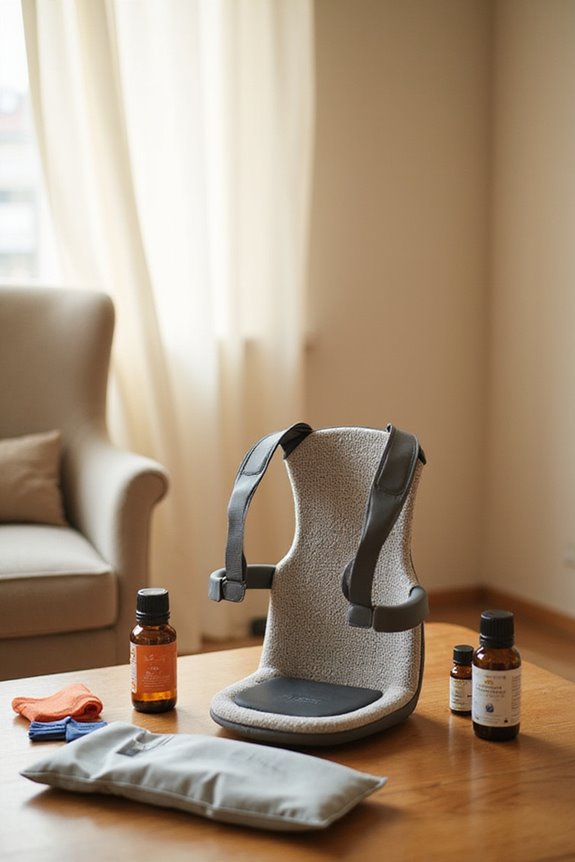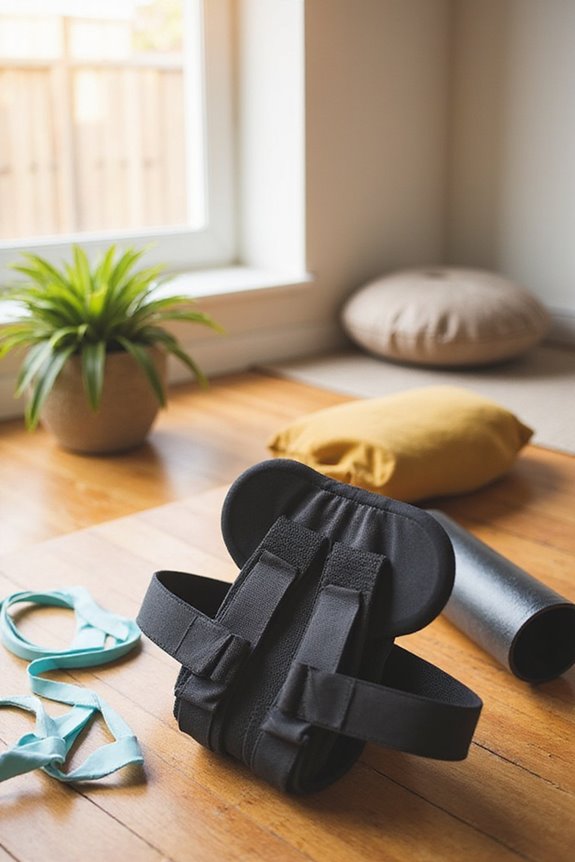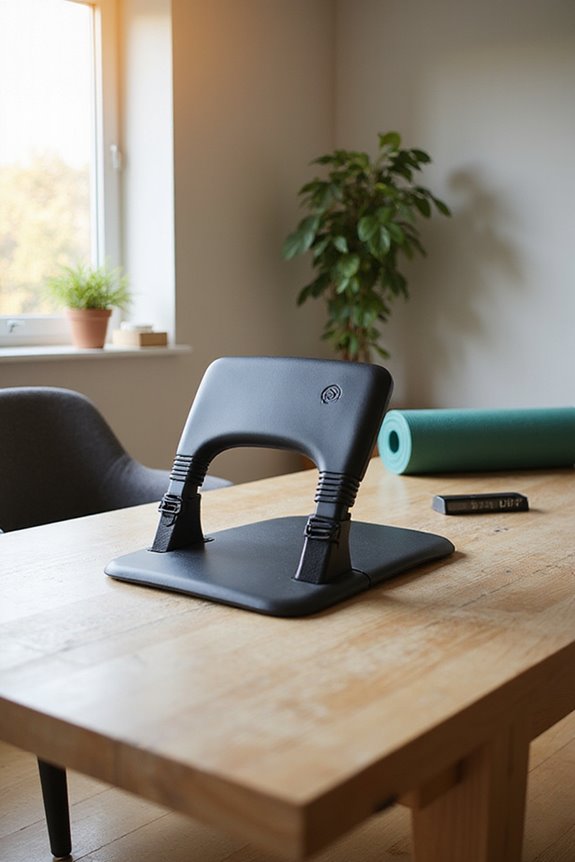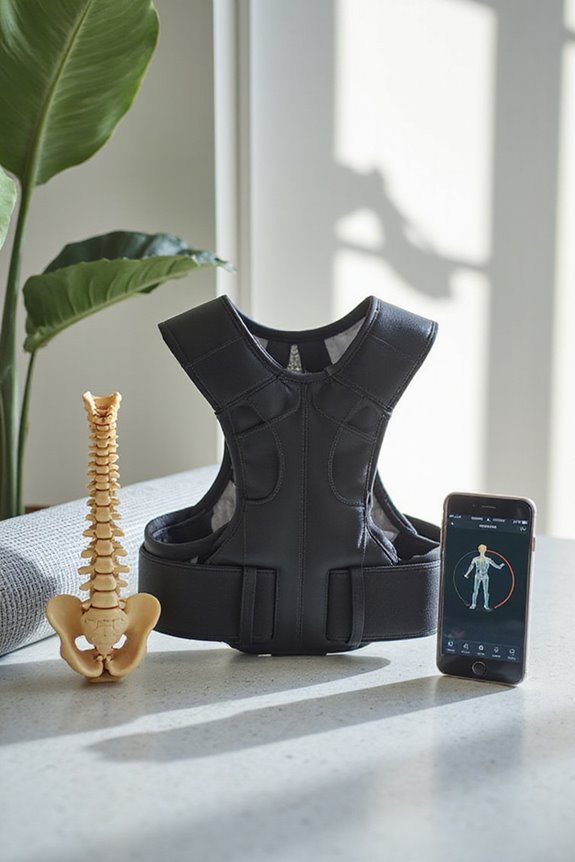A posture corrector offers multiple benefits, including:
- Increased Postural Awareness: Enhances proprioception, fostering better body alignment.
- Pain Relief: Supports spinal alignment to reduce muscle strain and discomfort.
- Muscle Strength: Improves muscle activation and flexibility, promoting core engagement.
- Productivity: Linked to a 40% decrease in back pain, enhancing focus and energy.
However, proper usage is essential to avoid dependence and muscle weakening. Further insights reveal additional advantages.
Key Takeaways
- Posture correctors enhance proprioception, improving awareness of body alignment and encouraging healthier postural habits.
- They provide support to the back and shoulders, reducing muscle strain and alleviating discomfort.
- Regular use can strengthen core muscles and improve spinal support, promoting better overall posture.
- Improved posture leads to increased concentration, energy levels, and overall productivity by minimizing discomfort.
- It is important to use posture correctors in moderation to avoid muscle dependency and atrophy.
Increased Postural Awareness
Postural awareness is a crucial aspect of maintaining spinal health and overall well-being. Increased awareness is facilitated through proprioceptive training, which enhances the body’s ability to sense its position in space.
Key benefits include:
- Heightened Sensory Input: Posture correctors stimulate proprioception, improving self-awareness of body alignment.
- Neural Pathway Reinforcement: Consistent use of posture correctors embeds long-term postural habits, reducing the need for conscious effort.
- Muscle Activation: Regular use encourages the engagement of postural stabilizer muscles, promoting correct spinal support.
- Visual and Tactile Feedback: Continuous reminders from posture correctors help users adjust their posture consistently, breaking poor habits.
Pain Relief and Discomfort Reduction

The use of posture correctors not only enhances postural awareness but also plays a significant role in pain relief and discomfort reduction.
- Spinal Alignment: These devices support the back and shoulders, improving spinal alignment. This alignment reduces strain on muscles and ligaments, ultimately alleviating neck, shoulder, and back pain.
- Nerve Compression: By enhancing posture, posture correctors may decrease nerve compression, which contributes to chronic pain sensations.
- Muscle Tension: They minimize excessive muscle activation caused by poor posture, reducing overall muscle tension and discomfort.
- Temporary Relief: While short-term use may provide temporary relief during activities that induce slouching, users should consider complementary approaches for sustained benefits.
Posture correctors serve as effective tools for individuals experiencing minor postural issues.
Muscle Strength and Flexibility Improvement

Muscle strength and flexibility improvement are critical components of effective posture management. Posture correctors facilitate muscle activation by providing cues that encourage proper alignment, retraining the brain to engage upper back and shoulder muscles effectively. This process aids in neuromuscular re-education, allowing muscles to remember correct posture over time.
- Enhanced muscle activation promotes better spinal support through core engagement.
- Studies show athletes experience improved shoulder strength with posture correctors.
- These devices also encourage stretching of the chest and anterior shoulder muscles, counteracting muscle shortening from slouching.
- Biofeedback features alert users to slouching, fostering active participation in maintaining posture.
Incorporating posture correctors with targeted exercises enhances their effectiveness, creating a balanced approach to strength and flexibility.
Productivity and Energy Benefits

Enhancing productivity and energy levels in the workplace can be greatly influenced by the use of posture correctors.
- Focus Enhancement: Posture correctors notably reduce back pain, with a reported 40% decrease within six months, leading to improved concentration and task efficiency.
- Energy Optimization: Proper alignment enhances oxygen intake and circulation, reducing fatigue and increasing alertness. Studies indicate that individuals using posture support experience elevated energy levels, facilitating longer work periods without strain.
- Cognitive Benefits: Improved posture correlates with better cognitive functions, promoting a positive mood and engagement.
Posture correctors not only alleviate discomfort but also foster a conducive environment for productivity, supporting a sustainable and effective workforce.
Limitations and Appropriate Usage

Limitations of posture correctors reveal important considerations for their effective use. While they can provide temporary support, prolonged wear may lead to posture dependency and muscle atrophy. Extended use often results in weakened core, back, and shoulder muscles, as users rely on the device rather than engaging their muscles naturally.
To optimize effectiveness, it is advisable to:
- Limit usage to a few hours daily.
- Combine with exercises that strengthen postural muscles.
- Guarantee proper fit to avoid discomfort and potential nerve compression.
Posture correctors should not be seen as long-term solutions but rather as short-term training aids, with thorough approaches including ergonomic education and therapeutic interventions being essential for lasting postural improvement.
Frequently Asked Questions
How Long Should I Wear a Posture Corrector Daily?
Wearing a posture corrector daily for up to six hours is recommended. This approach helps alleviate neck strain and can complement wrist support, fostering a sense of belonging to a community focused on enhancing overall well-being.
Can Posture Correctors Be Worn During Exercise?
Posture correctors can be worn during exercise to enhance posture alignment, potentially improving exercise benefits. They provide proprioceptive feedback, helping individuals maintain proper positioning, which may lead to reduced discomfort and better overall performance during physical activities.
Are There Specific Body Types That Benefit Most From Posture Correctors?
Studies suggest that 70% of office workers experience poor body alignment. Individuals with mild postural deviations often benefit from posture correctors, which provide ergonomic support and enhance awareness, fostering a sense of belonging in health-conscious communities.
Do Posture Correctors Come in Different Sizes and Styles?
Posture correctors indeed feature size variations to fit diverse body types, alongside style differences catering to personal preferences. Options range from strap-based designs to discreet shirt styles, allowing individuals to choose what best suits their needs.
Can Children Use Posture Correctors Safely?
Studies indicate that approximately 30% of children experience postural issues. Ensuring child safety, posture correctors can be utilized cautiously, fostering posture awareness and combining them with exercises for holistic development and muscular strength.



